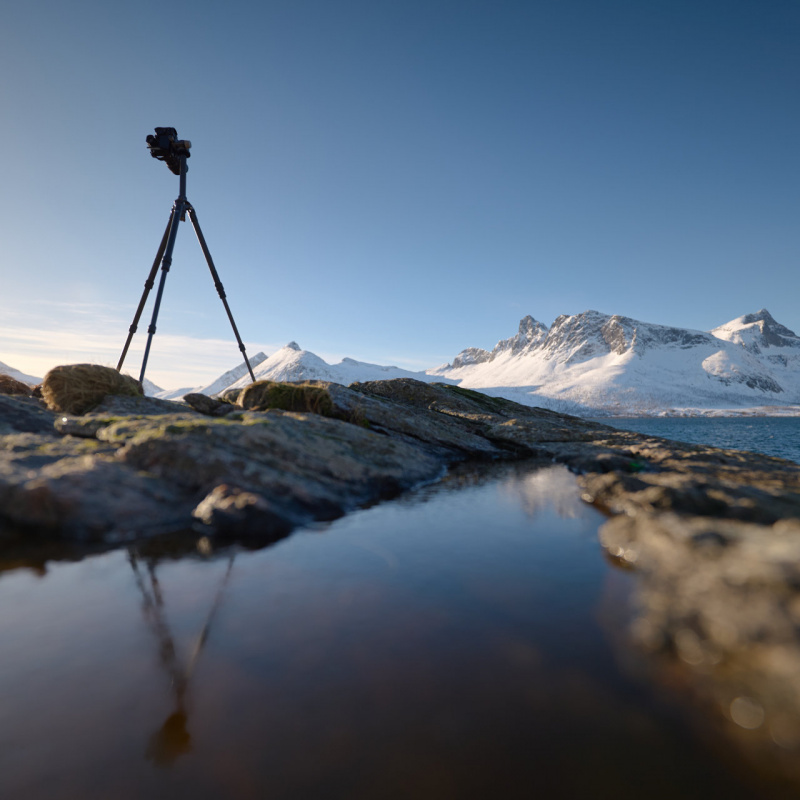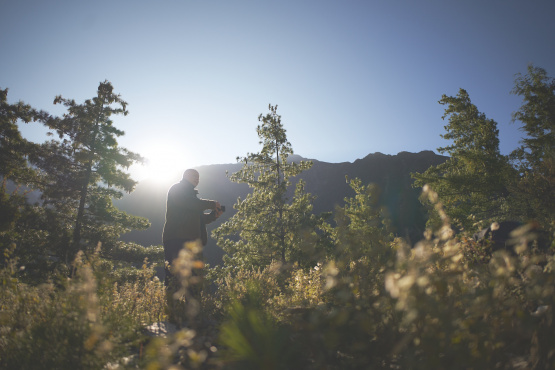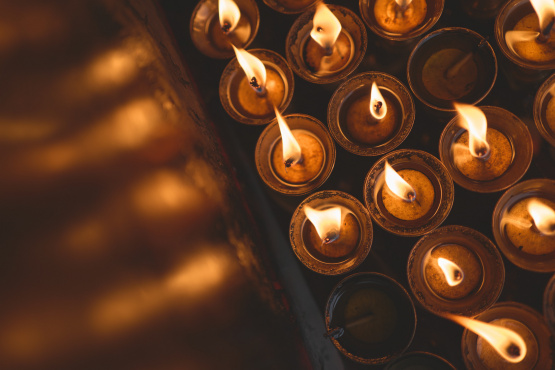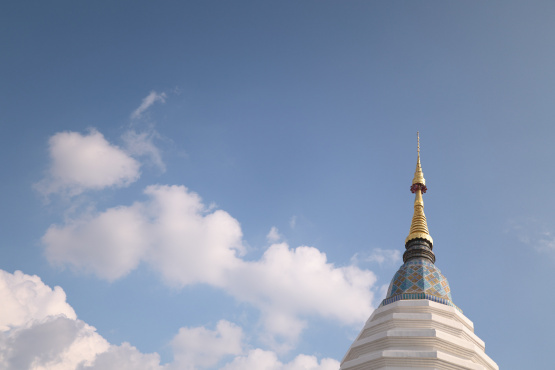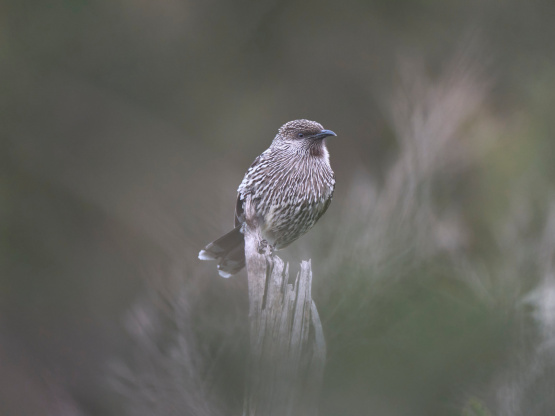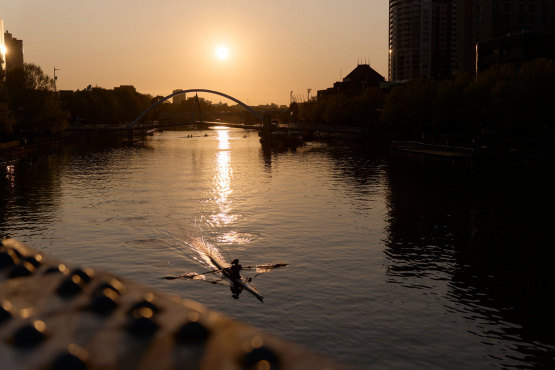Late afternoon has arrived in the Mustang region, west of the Nepalese Annapurna Ranges. Kagbeni is a gateway town, the last post before entering the Upper Mustang where a small chorten marks the way forward. The valley sweeps wide at this point, with a broad and flat moraine below filled with boulders, rocks and gravel left behind by the retreat of glaciers. Horses and goat herders cross the moraine, navigating the divergent branches of river flow with temporary wooden bridges made of logs and stone.
The sun has gone behind a mountain, just one of many massive peaks in this part of Nepal that is too small to earn a name. The valley is shaded, but a little of the sky is still illuminated as a dab of sunlight reaches over the mountain and through low clouds. The light is very soft. With the help of a graduated ND filter I can bring the clouds into the same exposure range as the shaded valley, and I snap a few variations to capture the silvery tones.
Photography is all about the light, but sometimes I have to look a closer to see the potential of that light as it fades into the evening. Softness in light is a wonderful quality to capture.
FIRST LIGHT
First light in the mornings is often warm and invariably soft. The sun is still cutting through a few thousand miles of atmosphere and hence is not at its brightest. This means that shadows in the composition are relatively soft shadows, gentle and embracing instead of harsh and cutting. Under the noon-day sun those same shadows become devastating for composition, much less forgiving than in that first hour of the day.
This is the charm of soft light, allowing you to emphasise the scene with long shadows but still kind enough to stay within a stop or two of dynamic range.
By the time your clock hits 9 in the morning the best of the days soft light has passed, and what remains is already harsh. In the first few minutes of sunrise you can even shoot portraits in that direct light and retain enough subtle detail to preserve skin tones wuth the help of some softening of a RAW file.
And the colours are warm, but only softly so. Evening sunsets are often dramatic and saturated with colour, the result of haze and pollution filling the distant horizon. Mornings are the opposite, clear and crisp as the night sky retreats to reveal the sun. Gently at first.
FLUSH COLOURS
Muted colours appeal to me greatly. Too much of modern photography, on film or digital, has resulted in hypersaturated hues that exaggerate reality and ultimately produces images that stand removed from reality. Muted tones from soft-light restores a gentle quality to your photographic expression, a sense of restraint and a more genuine representation.
If you can work in the range of muted tones more often it gives your work the impression of confidence, that you are happy with your work and don't need to resort to cheap theatrics by dragging your colour saturations to the right.
I might be a little at odds with dedicated landscape photographers here too. I know some talented chaps who do amazing things with film and seek to saturate their tones at sunset as much as possible. They underexpose the film and over-saturate the prints to get the maximum colour. But to what end? When is the colour enough colour? Sometimes less is more, even where landscapes are concerned.
My hero for fine art landscapes is Murray Frederick, whose sensitive captures of salt lakes and moody skies are beautifully controlled. His work shows a master of colour instead being a slave to it.
PRETTY PEOPLE
I've always advocated that you should treat your portraits as you do your photos, and try to put them in the best light. Soft filtered light dimly creeping in through a window or a doorway is one of my favourites when taking portraits. It often requires working at a higher ISO to get a clear shot, but that should never be an obstacle to your composition. Our lovely modern digital SLRs are very capable, and ever more so when shooting RAW.
I love shooting people on a cloudy day, a dim doorway or sitting in the shade of a tree while the sun blazes away nearby. I don't mind blowing out the background a little and letting the subject stand firm in the foreground. Where the light is soft the composition is kind.
Little surprise that when you walk into the harsh light of day we reach for the sunglasses, something to sheild the unwanted abundance of light. If our own eyes avoid direct sunlight, then it's better we avoid photographing someone elses eye in direct sunlight. Truly bright eyes are the result of being open to the camera, and truly great portraits require a subject who is comfortable in the light. A little bit of light, not too much.
GRADUALLY INCLINED
Sometimes the dark and heavy light of dusk, with clouds riding high above, is very soft and potentially very flat. Enter the Graduated ND filter. These cheap and easy to pack but of gear is an essential part of a well packed camera bag. There is no need for elaborate filter holders and tripods – just slip one across the lens itself with one hand and compose with the other. Perfection comes with practice, just buy a bag of cheap ones and start experimenting with their effects.
Mostly I use an ND Graduated filter to balance water and sky, because relfections off a still lake are several stops darker than what they are reflecting. You can also use the grad filter to bring darker tones to a cloudy sky, adding some mood to an otherwise flat landscape image. ND stands for neutral density, so it stands to reason that such a filter can help soften the light to good effect.
Polarizers are the opposite, selectively removing light at certain angles and effectively adding contrast to a brightly illuminated scene. The general rule for a polarizer is that they have the most impact when the light is already a problem.
After a few weeks of travelling through Nepal and the mountain trails of the Annapurnas I was impressed not only by the clear air and vivid mornings, but the gentle quality of the light that falls on serene landscapes on a cloudy day. Too often I overlook the variety of light once the sun has turned shy. I watched my fellow travellers shoot madly at the impressive valleys below us from the town of Kagbeni, and was reminded of how charming the soft light can be.
Grey is not always grey, it can be silver too.

Keep Reading
Join Ewen's newsletter for monthly updates on new photography articles and tour offers...Subscribe Here


